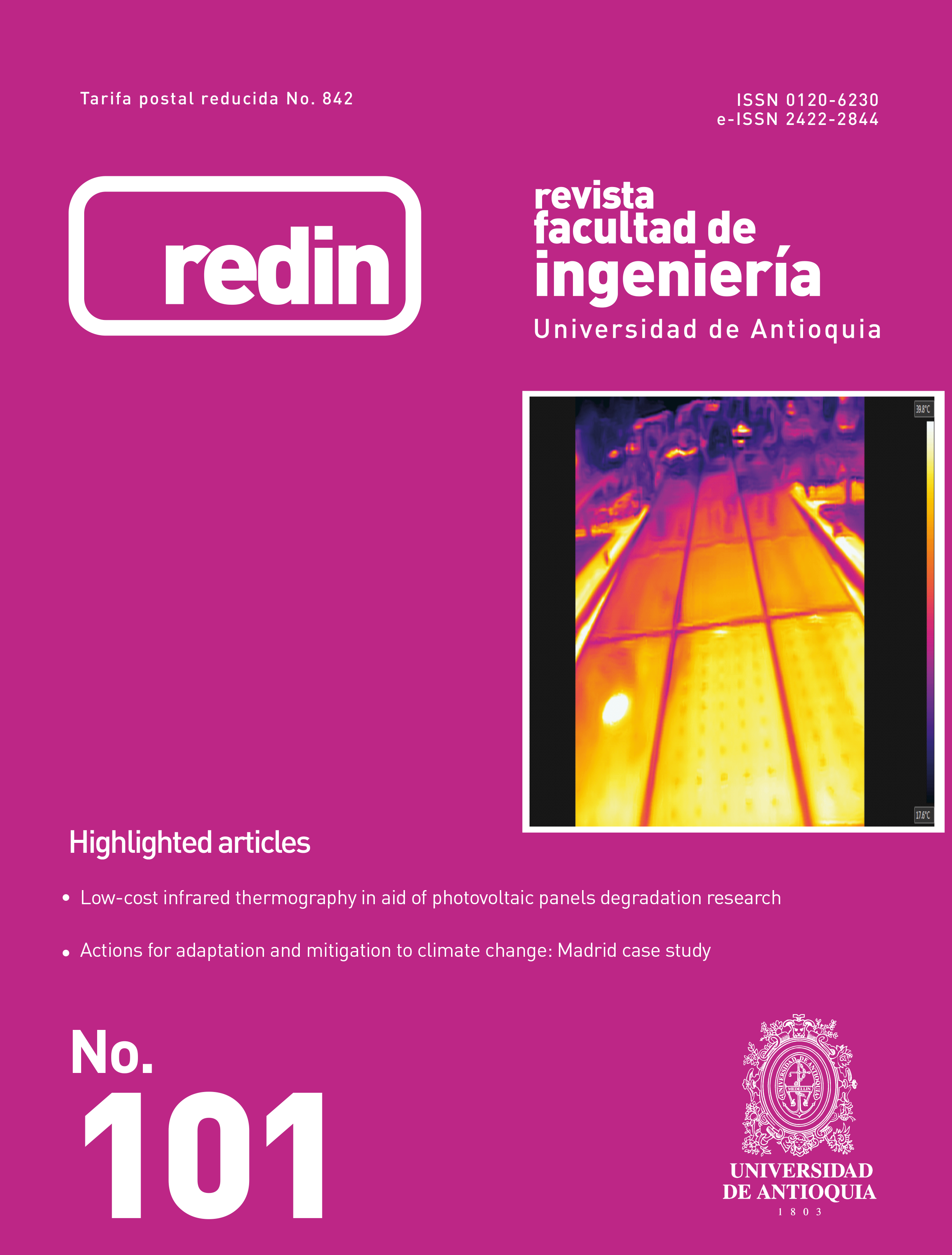Low-cost infrared thermography in aid of photovoltaic panels degradation research
DOI:
https://doi.org/10.17533/udea.redin.20200689Keywords:
thermography, low cost, thermal camera, image processing, temperature sensorAbstract
The analysis of PV solar panels deterioration allows researchers to know the health status of a panel in order to determine the overall functioning of a PV solar farm. A part of this analysis is performed by thermography, generally using professional and expensive equipment. This article presents a validation for the use of low-cost thermal imaging cameras, reviewing the relative error that can be obtained through scattering, contour analysis and three-dimensional meshes. The procedure is validated by analysis of I-V/P-V curves and a temperature sensor matrix, reaching errors less than 10% with cameras with less than 500USD.
Downloads
References
R. Usamentiaga and et al, “Infrared thermography for temperature measurement and non-destructive testing,” Sensors (Basel), vol. 14, no. 7, July 2014. [Online]. Available: https://doi.org/10.3390/s140712305
K. Delac and M. Grgic, “Detecting hot spots in photovoltaic panels using low-cost thermal cameras,” in Ibero-American Congress on Information Management and Big Data (ICSC-CITIES 2019), 2019, pp. 38– 53.
P. Battalwar, J. Gokhale, and U. Bansod, “Infrared thermography and IR camera,” Int. J. Res. Sci. Eng, vol. 1, no. 3, pp. 9–14, 2015.
E. Ruggeri, B. B. Van, O. Isabella, and M. Zeman, “Electroluminescence and dark lock-in thermography for the quality assessment of metal-wrap-through solar devices,” IEEE Journal of Photovoltaics, vol. 8, no. 5, September 2018. [Online]. Available: https://doi.org/10.1109/JPHOTOV.2018.2850530
C. Toledo, L. Serrano, J. Abad, A. Lampitelli, and A. Urbina, “Measurement of thermal and electrical parameters in photovoltaic systems for predictive and cross-correlated monitorization,” Energies, vol. 12, no. 4, February 2019. [Online]. Available: https://doi.org/10.3390/en12040668
R. L. Do Santos, J. S. Ferreira, G. E. Martins, K. C. de Souza, and E. M. Sá, “Low cost educational tool to trace the curves PV modules,” IEEE Latin America Transactions, vol. 15, no. 8, January 2017. [Online]. Available: https://doi.org/10.1109/TLA.2017.7994784
M. Dhimish, V. Holmes, B. Mehrdadi, M. Dales, and P. Mather, “PV output power enhancement using two mitigation techniques for hot spots and partially shaded solar cells,” Electr. Power Syst. Res., vol. 158, May 2018. [Online]. Available: https://doi.org/10.1016/j.epsr.2018.01.002
M. Dhimish and V. Holmes and B. Mehrdadi and M. Dales and P. Mather, “Design and implementation of a photovoltaic I-V curve tracer: Solar modules characterization under real operating conditions,” Energy Convers. Manag., vol. 169, August 1 2018. [Online]. Available: https://doi.org/10.1016/j.enconman.2018.05.046
Z. A. Jaffery, A. K. Dubey, Irshad, and A. Haque, “Scheme for predictive fault diagnosis in photovoltaic modules using thermal imaging,” Infrared Phys. Technol., vol. 83, June 2017. [Online]. Available: https://doi.org/10.1016/j.infrared.2017.04.015
A. M. Salazar and E. Q. Macabebe, “Hotspots detection in photovoltaic modules using infrared thermography,” MATEC Web of Conferences, vol. 70, January 2016. [Online]. Available: https://doi.org/10.1051/matecconf/20167010015
J. L. Espinoza, L. G. Gonzalez, and R. Sempertegui, “Micro grid laboratory as a tool for research on non-conventional energy sources in Ecuador,” in 2017 IEEE International Autumn Meeting on Power, Electronics and Computing (ROPEC), Ixtapa, Mexico, 2017.
FLIR® Systems, Inc. Thermal analysis and reporting (desktop)FLIR tools. [FLIR Systems, Inc.]. Accessed Nov. 14, 2019. [Online]. Available: https://bit.ly/2TOlRNu
Solmetric Corporation. (2010) Solmetric PVA-600 PV Analyzer User’s Guide. Solmetric Corporation. [Online]. Available: https://bit.ly/3cfmwhw
Athersa. (2019) Paneles solares policristalinos. [Athersa Shop]. Accessed Nov, 2019. [Online]. Available: https://bit.ly/3gKFa4r
N. Kawasaki, “Energía fotovoltaica, trazador de curvas V-I para seguimiento de módulos solares,” Undergraduate degree, Departamento de Sistemas Energéticos, Universidad Politécnica de Madrid, Madrid, España, 1996.
A. Hemza, H. Abdeslam, C. Rachid, and N. Aoun, “Simplified methods for evaluating the degradation of photovoltaic module and modeling considering partial shading,” Meas. J. Int. Meas. Confed., vol. 138, February 2019. [Online]. Available: http://dx.doi.org/10.1016/j.measurement.2019.01.098
J. E. Quiroz, J. S. Stein, C. K. Carmignani, and K. Gillispie, “Insitu module-level I-V tracers for novel PV monitoring,” in 2015 IEEE 42nd Photovoltaic Specialist Conference (PVSC), New Orleans, LA, USA, 2015.
K. A. Kim, G. S. Seo, B. H. Cho, and P. T. Krein, “Photovoltaic hot-spot detection for solar panel substrings using AC parameter characterization,” IEEE Trans. Power Electron., vol. 31, no. 2, February 2016. [Online]. Available: http://dx.doi.org/10.1109/TPEL.2015.2417548
S. Gallardo, L. Hernandez, and O. Duque, “Image resolution influence in aerial thermographic inspections of photovoltaic plants,” IEEE Trans. Ind. Informatics, vol. 14, no. 12, December 2016. [Online]. Available: http://dx.doi.org/10.1109/TII.2018.2865403
W. Zaaiman. (2012) Solar irradiance and photovoltaic measurements from solar radiation to PV arrays. European Commission, Joint Research Center. Ispra, ITL.
W. Chine and et al, “A novel fault diagnosis technique for photovoltaic systems based on artificial neural networks,” Renew. Energy, vol. 90, May 2016. [Online]. Available: https://doi.org/10.1016/j.renene.2016.01.036
R. Koprowski, “Some selected quantitative methods of thermal image analysis in Matlab,” J. Biophotonics, vol. 9, no. 5, May 2016. [Online]. Available: https://doi.org/10.1002/jbio.201500224
J. A. Tsanakas, L. Ha, and C. Buerhop, “Faults and infrared thermographic diagnosis in operating c-Si photovoltaic modules: A review of research and future challenges,” Renewable and Sustainable Energy Reviews, vol. 62, September 2016. [Online]. Available: https://doi.org/10.1016/j.rser.2016.04.079
Published
How to Cite
Issue
Section
License
Copyright (c) 2019 Revista Facultad de Ingeniería Universidad de Antioquia

This work is licensed under a Creative Commons Attribution-NonCommercial-ShareAlike 4.0 International License.
Revista Facultad de Ingeniería, Universidad de Antioquia is licensed under the Creative Commons Attribution BY-NC-SA 4.0 license. https://creativecommons.org/licenses/by-nc-sa/4.0/deed.en
You are free to:
Share — copy and redistribute the material in any medium or format
Adapt — remix, transform, and build upon the material
Under the following terms:
Attribution — You must give appropriate credit, provide a link to the license, and indicate if changes were made. You may do so in any reasonable manner, but not in any way that suggests the licensor endorses you or your use.
NonCommercial — You may not use the material for commercial purposes.
ShareAlike — If you remix, transform, or build upon the material, you must distribute your contributions under the same license as the original.
The material published in the journal can be distributed, copied and exhibited by third parties if the respective credits are given to the journal. No commercial benefit can be obtained and derivative works must be under the same license terms as the original work.










 Twitter
Twitter